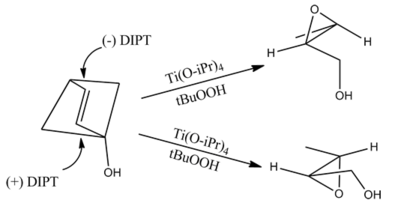Sharpless epoxidation
The Sharpless Epoxidation reaction is an enantioselective chemical reaction to prepare 2,3-epoxyalcohols from primary and secondary allylic alcohols.[1][2]

The stereochemistry of the resulting epoxide is determined by the diastereomer of the chiral tartrate diester (usually diethyl tartrate or diisopropyl tartrate) employed in the reaction. The oxidizing agent is tert-butyl hydroperoxide. Enantioselectivity is achieved by a catalyst formed from titanium tetra(isopropoxide) and diethyl tartrate. Only 5-10 mol% of the catalyst in the presence of 3Å molecular sieves (3Å MS) is necessary.[3]
The Sharpless Epoxidation's success is due to five major reasons. First, epoxides can be easily converted into diols, aminoalcohols or ethers, so formation of chiral epoxides is a very important step in the synthesis of natural products. Second, the Sharpless Epoxidation reacts with many primary and secondary allylic alcohols. Third, the products of the Sharpless Epoxidation frequently have enantiomeric excesses above 90%. Fourth, the products of the Sharpless Epoxidation are predictable using the Sharpless Epoxidation model. Finally, the reactants for the Sharpless Epoxidation are commercially available and relatively cheap.[4]
Several reviews have been published.[5][6][7][8]
K. Barry Sharpless shared the 2001 Nobel prize in Chemistry for his work on asymmetric oxidations. The prize was shared with William S. Knowles and Ryōji Noyori.
Catalyst Structure
The structure of the catalyst is still uncertain. No studies have been conducted that definitively exclude other proposed catalysts. Regardless, all studies have concluded that the catalyst is a dimer of [Ti(tartrate)(OR)2] The putative catalyst was determined using X-ray structural determinations of model complexes which have the necessary structural components to catalyze the Sharpless Epoxidation.[9]

Selectivity
The chirality of the product of a Sharpless epoxidation can be predicted using the following mnemonic. Draw the double bond of interest lying flat. Draw a rectangle that around the double bond in the same plane as the carbons of the double bond. Towards the bottom right corner, draw the allylic alcohol. Place the other substituents in the appropriate corners. In this orientation, the (-) diester tartrate preferentially interacts with the top half of the molecule, and the (+) diester tartrate preferentially interacts with the bottom half of the molcule. This model seems to be valid despite substitution on the olefin. Selectivity decreases with larger R1, but increases with larger R2 and R3 (see introduction).[10]

The product of allylic 1,2-diols is incorrectly predicted by this model.[11]

Kinetic Resolution
The Sharpless Epoxidation can also give kinetic resolution of a racemic mixture of secondary 2,3-epoxyalcohols. While the yield of a kinetic resolution process cannot be higher than 50%, the enantiomeric excess approaches 100% in some reactions.[12][13]

Synthetic Utility
The Sharpless Epoxidation is viable with a large range of primary and secondary olefinic alcohols. Furthermore, with the exception noted above, a given dialkyl tartrate will preferentially add to the same face independent of the substitution on the olefin.[14] To demonstrate the synthetic utility of the Sharpless Epoxidation, the Sharpless group created synthetic intermediates of various natural products: methymycin, erythromycin, leukotriene C-1, and (+)-disparlure.[15]

As one of the few, highly enantioselective reactions during its time, many manipulations of the of the 2,3-epoxyalcohols have been developed.[16]
The Sharpless Epoxidation has been used for the total synthesis of various carbohydrates, terpenes, leukotrienes, pheromones, and antibiotics.[17]
See also
References
- ^ Katsuki, T.; Sharpless, K. B. J. Am. Chem. Soc. 1980, 102, 5974. (doi:10.1021/ja00538a077)
- ^ Hill, J. G.; Sharpless, K. B.; Exon, C. M.; Regenye, R. Org. Syn., Coll. Vol. 7, p.461 (1990); Vol. 63, p.66 (1985). (Article)
- ^ Gao, Y.; Hanson, R. M.; Klunder, J. M.; Ko, S. Y.; Masamune, H.; Sharpless, K. B. J. Am. Chem. Soc. 1987, 109, 5765-5780. (doi:10.1021/ja00253a032)
- ^ Uetikon, C. F. Synthesis (Stuttgart) 1986, 88-116.
- ^ Johnson, R. A.; Sharpless, K. B. Comp. Org. Syn. 1991, 7, 389-436. (Review)
- ^ Hüft, E. Top. Curr. Chem. 1993, 164, 63-77. (Review)
- ^ Katsuki, T.; Martin, V. S. Org. React. 1996, 48, 1-300. (Review)
- ^ Pfenninger, A. Synthesis 1986, 89-116. (Review)
- ^ Finn, M. G.; Sharpless, K. B. J. Am. Chem. Soc. 1991, 113, 113-126. (doi:10.1021/ja00001a019)
- ^ Katsuki, T.; Sharpless, K. B. J. Am. Chem. Soc. 1980, 102, 5974. (doi:10.1021/ja00538a077)
- ^ Takano, S.; Iwabuchi, Y.; Ogasawara, K. J. Am. Chem. Soc. 1991, 113, 2786-2787. (doi:10.1021/ja00007a082)
- ^ Kitano, Y.; Matsumoto, T.; Sato, F. Tetrahedron 1988, 44, 4073-4086.
- ^ Martin, V.; Woodard, S.; Katsuki, T.; Yamada, Y.; Ikeda, M.; Sharpless, K. B. J. Am. Chem. Soc. 1981, 103, 6237-6240. (doi:10.1021/ja00410a053)
- ^ Katsuki, T.; Sharpless, K. B. J. Am. Chem. Soc. 1980, 102, 5974. (doi:10.1021/ja00538a077)
- ^ Rossiter, B.; Katsuki, T.; Sharpless, K. B. J. Am. Chem. Soc. 1981, 103, 464-465. (doi:10.1021/ja00392a038)
- ^ Sharpless, K. B.; Behrens, C. H.; Katsuki, T.; Lee, A. W. M.; Martin, V. S.; Takatani, M.; Viti, S.M.; Walker, F. J.; Woodard, S. S. Pure Appl. Chem. 1983, 55, 589.
- ^ Uetikon, C. F. Synthesis (Stuttgart) 1986, 88-116.
